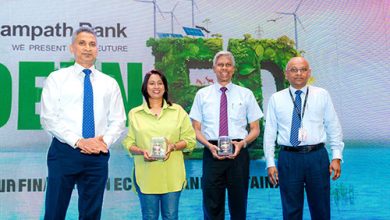BANK OF CEYLON
“Bank of Ceylon helped revolutionise agriculture through drones and empower young entrepreneurs”
- Kenilworth International Managing Director Kavinda Dissanayake on how his partnership with BOC is revolutionising local farming
Drones are rapidly transforming various industries worldwide, and Sri Lanka’s agricultural sector is no exception. Kenilworth International, a company originally focused on security technology, has been at the forefront of introducing drone applications in agriculture. With the support of the Bank of Ceylon, the company has expanded its operations, tackling challenges related to cost, accessibility, and regulatory frameworks.
Kavinda Dissanayake, Managing Director of Kenilworth International, discusses how the company transitioned into the agricultural sector, the financial backing required for scaling up, and the tangible benefits drone technology has brought to paddy and tea plantations. He also outlines future plans for expansion beyond agriculture and emphasises the role of data-driven farming in shaping Sri Lanka’s agricultural landscape over the next decade.
In this interview, Dissanayake provides insights into the company’s journey, the financial considerations of drone adoption, and the future potential of drone technology in Sri Lanka.
Following are the excerpts of the interview.
What motivated Kenilworth International to introduce drone technology in Sri Lanka’s agriculture, and what were the biggest challenges in its early adoption?
Kenilworth International was established in 2013 and initially focused on security technology. Drones were already a part of our security solutions, but we later identified an opportunity to extend their use into agriculture. Recognising the potential benefits, we decided it was the right time to step into agricultural drone applications.
How did financial support from the Bank of Ceylon help in scaling up drone operations, and which areas of the project benefited the most from this investment?
Training professional drone pilots was a key investment area. A single pilot requires around LKR 500,000 for training because industrial drones demand advanced skills beyond those needed for photography or videography drones. Ensuring skilled operators was essential for safe and effective use.
Additionally, we invested heavily in acquiring state-of-the-art drones. Some of our equipment is less than six months old in the global market. Another critical investment area was public awareness—educating farmers and stakeholders on how to integrate drones into their agricultural practices.
Securing financial backing was challenging, as drones were a novel concept in Sri Lanka, with no collateral value. The Bank of Ceylon recognized the potential and took a calculated risk by partially funding our capital requirements, which played a crucial role in scaling up our operations.
How has Kenilworth International ensured that drone technology remains accessible and affordable for smallholder farmers, given the high costs associated with advanced equipment and training?
Cost-effectiveness is a significant advantage of drone technology. For instance, paddy farmers typically spend between LKR 2,500 and 3,000 per acre for manual spraying, whereas drones can complete the task for around LKR 1,060 per acre. This substantial cost reduction makes drones an attractive alternative.
Moreover, drones significantly reduce the time required for spraying. While traditional methods take five to six hours per acre, drones can accomplish the same task in just 10 minutes. Another major benefit is the elimination of direct exposure to hazardous chemicals, ensuring farmers’ health and safety.
Additionally, drones store and analyze data, allowing farmers to track chemical usage, optimize future applications, and enhance productivity through data-driven decision-making.
What measurable impact has drone technology had on efficiency, cost reduction, and sustainability in paddy, tea, and other plantation industries?
The impact on tea plantations has been particularly significant, with confirmed increases in green leaf yield of over 30%. This productivity boost has led to widespread adoption among tea estates.
The government is also recognizing the value of this technology. Recently, the State Plantation Corporation conducted trials and is now considering integrating drones into public sector agriculture. Drone spraying ensures even chemical distribution, optimizing plant health and improving yields.
How has the collaboration between Kenilworth International and the Bank of Ceylon contributed to the large-scale adoption of drones in agriculture?
We have already completed the initial phase and are preparing for expansion. We have engaged in discussions with Bank of Ceylon about potential loan opportunities for individuals who wish to invest in drones and lease them for operational services.
Beyond agriculture, does Kenilworth International have plans to expand drone applications into areas such as infrastructure, environmental monitoring, or disaster response?
Yes, we are already exploring multiple avenues. One key area is coastal surveillance, where long-range drones can assist in monitoring illegal activities and delivering essential supplies to remote locations.
We are also considering infrastructure maintenance, particularly for high-tension power lines, which many countries inspect using drones. Another application is security and surveillance, where drones can enhance monitoring capabilities. Additionally, drones equipped for firefighting could be a valuable addition in emergency response scenarios.
Where do you see drone technology in Sri Lanka’s agriculture and other fields over the next five to ten years? How can institutions like the Bank of Ceylon support this growth?
Agriculture is rapidly evolving toward precision and data-driven farming. Drones will play a crucial role in this transformation by collecting and analyzing data to optimize resource allocation. For example, rather than applying fertilizer uniformly, drones can assess soil conditions and determine the precise quantity needed for each section, reducing waste and improving efficiency.
Water conservation is another critical benefit. On some plantations, our drones have helped save five million liters of water annually by reducing spray volumes from 400 liters to 100 liters per hectare. This level of efficiency is crucial for sustainable agriculture.
Financial institutions like the Bank of Ceylon can continue supporting this growth by providing capital for technology upgrades, as drones require continuous advancements. The bank’s willingness to think beyond conventional lending models has already been instrumental in bringing drone technology to Sri Lanka, and continued support will ensure its long-term success.
Kavinda Dissanayake






